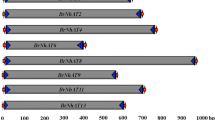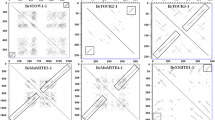Abstract
Sequencing of plant genomes often identified the hAT superfamily as the largest group of DNA transposons. Nevertheless, detailed information on the diversity, abundance and chromosomal localization of plant hAT families are rare. By in silico analyses of the reference genome assembly and bacterial artificial chromosome (BAC) sequences, respectively, we performed the classification and molecular characterization of hAT transposon families in Musa acuminata. Musa hAT transposons are organized in three families designated MuhAT I, MuhAT II and MuhAT III. In total, 70 complete autonomous elements of the MuhAT I and MuhAT II families were detected, while no autonomous MuhAT III transposons were found. Based on the terminal inverted repeat (TIR)-specific sequence information of the autonomous transposons, 1722 MuhAT I- and MuhAT II-specific miniature inverted-repeat transposable elements (MuhMITEs) were identified. Autonomous MuhAT I and MuhAT II elements are only moderately abundant in the sections of the genus Musa, while the corresponding MITEs exhibit an amplification in Musa genomes. By fluorescent in situ hybridization (FISH), autonomous MuhAT transposons as well as MuhMITEs were localized in subtelomeric, most likely gene-rich regions of M. acuminata chromosomes. A comparison of homoeologous regions of M. acuminata and Musa balbisiana BACs revealed the species-specific mobility of MuhMITEs. In particular, the activity of MuhMITEs II showing transduplications of genomic sequences might indicate the presence of active MuhAT transposons, thus suggesting a potential role of MuhMITEs as modulators of genome evolution of Musa.








Similar content being viewed by others
References
Alix K, Heslop-Harrison JS (2004) The diversity of retroelements in diploid and allotetraploid Brassica species. Plant Mol Biol 54:895–909
Benjak A, Forneck A, Casacuberta JM (2008) Genome-wide analysis of the “cut-and-paste” transposons of grapevine. PLoS ONE 3:e3107
Benjak A, Boué S, Forneck A, Casacuberta JM (2009) Recent amplification and impact of MITEs on the genome of grapevine (Vitis vinifera L.). Genome Biol Evol 20:75–84
Bennetzen JL (2005) Transposable elements, gene creation and genome rearrangement in flowering plants. Curr Opin Genet Dev 15:621–627
Birney E, Clamp M, Durbin R (2004) GeneWise and Genomewise. Genome Res 14:988–995
Capy P, Bazin C, Higuet D, Langin T (1998) Dynamics and evolution of transposable elements. Springer, Austin
Cavallini A, Natali L, Zuccolo A, Giordani T, Jurman I, Ferrillo V, Vitacolonna N, Sarri V, Cattonaro F, Ceccarelli M, Cionini PG, Morgante M (2010) Analysis of transposons and repeat composition of the sunflower (Helianthus annuus L.) genome. Theor Appl Genet 120:491–508
Chen J, Hu Q, Zhang Y, Lu C, Kuang H (2014) P-MITE: a database for plant miniature inverted-repeat transposable elements. Nucleic Acids Res 42:D1176–D1181
Cheung F, Town CD (2007) A BAC end view of the Musa acuminata genome. BMC Plant Biol 7:29
Crooks GE, Hon G, Chandonia JM, Brenner SE (2004) WebLogo: a sequence logo generator. Genome Res 14:1188–1190
D’Hont A, Denoeud F, Aury JM, Baurens FC, Carreel F, Garsmeur O, Noel B, Bocs S, Droc G, Rouard M, Da Silva C, Jabbari K, Cardi C, Poulain J, Souquet M, Labadie K, Jourda C, Lengellé J, Rodier-Goud M, Alberti A, Bernard M, Correa M, Ayyampalayam S, Mckain MR, Leebens-Mack J, Burgess D, Freeling M, Mbéguié-A-Mbéguié D, Chabannes M, Wicker T, Panaud O, Barbosa J, Hribova E, Heslop-Harrison P, Habas R, Rivallan R, Francois P, Poiron C, Kilian A, Burthia D, Jenny C, Bakry F, Brown S, Guignon V, Kema G, Dita M, Waalwijk C, Joseph S, Dievart A, Jaillon O, Leclercq J, Argout X, Lyons E, Almeida A, Jeridi M, Dolezel J, Roux N, Risterucci AM, Weissenbach J, Ruiz M, Glaszmann JC, Quétier F, Yahiaoui N, Wincker P (2012) The banana (Musa acuminata) genome and the evolution of monocotyledonous plants. Nature 488:213–217
Davey MW, Gudimella R, Harikrishna JA, Sin LW, Khalid N, Keulemans W (2013) A draft Musa balbisiana genome sequence for molecular genetics in polyploid, inter- and intra-specific Musa hybrids. BMC Genomics 14:683
de Freitas Ortiz M, Lorenzatto KR, Corrêa BR, Loreto EL (2010) hAT transposable elements and their derivatives: an analysis in the 12 Drosophila genomes. Genetica 138:649–655
Desel C (2002) Chromosomale Lokalisierung von repetitiven und unikalen DNA-Sequenzen durch Fluoreszenz- in situ- Hybridisierung in der Genomanalyse bei Beta-Arten. Dissertation, University of Kiel
Droc G, Lariviere D, Guignon V, Yahiaoui N, This D, Garsmeur O, Dereeper A, Hamelin C, Argout X, Dufayard J-F, Lengelle J, Baurens F-C, Cenci A, Pitollat B, D’Hont A, Ruiz M, Rouard M, Bocs S (2013) The Banana Genome Hub. Database. doi:10.1093/database/bat035
Du J, Grant D, Tian Z, Nelson RT, Zhu L, Shoemaker RC, Ma J (2010) SoyTEdb: a comprehensive database of transposable elements in the soybean genome. BMC Genomics 11:113
Eddy SR (1998) Profile hidden Markov models. Bioinformatics 14:755–763
Feschotte C, Jiang N, Wessler SR (2002) Plant transposable elements: where genetics meets genomics. Nat Rev Genet 3:329–341
Feschotte C, Swamy L, Wessler SR (2003) Genome-wide analysis of mariner-like transposable elements in rice reveals complex relationships with stowaway miniature inverted repeat transposable elements (MITEs). Genetics 163:747–758
Finnegan DJ (1989) Eukaryotic transposable elements and genome evolution. Trends Genet 5:103–107
Fujino K, Sekiguchi H, Kiguchi T (2005) Identification of an active transposon in intact rice plants. Mol Genet Genomics 273:150–157
Gambin T, Startek M, Walczak K, Paszek J, Grzebelus D, Gambin A (2013) TIRfinder: a web tool for mining class II transposons carrying terminal inverted repeats. Evol Bioinform Online 9:17–27
Häkkinen M (2013) Reappraisal of sectional taxonomy in Musa (Musaceae). Taxon 62:809–813
Hartings H, Rossi V, Lazzaroni N, Thompson RD, Salamini F, Motto M (1991) Nucleotide sequence of the Bg transposable element of Zea mays L. Maydica 36:355–359
Heslop-Harrison JS, Schwarzacher T (2007) Domestication, genomics and the future for banana. Ann Bot 100:1073–1084
Heslop-Harrison JS, Schwarzacher T (2011) Organisation of the plant genome in chromosomes. Plant J 66:18–33
Holligan D, Zhang X, Jiang N, Pritham EJ, Wessler SR (2006) The transposable element landscape of the model legume Lotus japonicus. Genetics 174:2215–2228
Huang J, Zhang K, Shen Y, Huang Z, Li M, Tang D, Gu M, Cheng Z (2009) Identification of a high frequency transposon induced by tissue culture, nDaiZ, a member of the hAT family in rice. Genomics 93:274–281
Juretic N, Hoen DR, Huynh ML, Harrison PM, Bureau TE (2005) The evolutionary fate of MULE-mediated duplications of host gene fragments in rice. Genome Res 15:1292–1297
Kuromori T, Hirayama T, Kiyosue Y, Takabe H, Mizukado S, Sakurai T, Akiyama K, Kamiya A, Ito T, Shinozaki K (2004) A collection of 11 800 single-copy Ds transposon insertion lines in Arabidopsis. Plant J 37:897–905
Macas J, Koblízková A, Neumann P (2005) Characterization of Stowaway MITEs in pea (Pisum sativum L.) and identification of their potential master elements. Genome 48:831–839
Menzel G, Dechyeva D, Keller H, Lange C, Himmelbauer H, Schmidt T (2006) Mobilization and evolutionary history of miniature inverted-repeat transposable elements (MITEs) in Beta vulgaris L. Chromosome Res 14:831–844
Menzel G, Krebs C, Diez M, Holtgräwe D, Weisshaar B, Minoche AE, Dohm JC, Himmelbauer H, Schmidt T (2012) Survey of sugar beet (Beta vulgaris L.) hAT transposons and MITE-like hATpin derivatives. Plant Mol Biol 78:393–405
Moon S, Jung KH, Lee DE, Jiang WZ, Koh HJ, Heu MH, Lee DS, Suh HS, An G (2006) Identification of active transposon dTok, a member of the hAT family, in rice. Plant Cell Physiol 47:1473–1483
Moreno-Vázquez S, Ning J, Meyers BC (2005) hATpin, a family of MITE-like hAT mobile elements conserved in diverse plant species that forms highly stable secondary structures. Plant Mol Biol 58:869–886
Novák P, Hřibová E, Neumann P, Koblížková A, Doležel J, Macas J (2014) Genome-wide analysis of repeat diversity across the family Musaceae. PLoS ONE 9:e98918
Rubin E, Lithwick G, Levy AA (2001) Structure and evolution of the hAT transposon superfamily. Genetics 158:949–957
Saghai-Maroof MA, Soliman KM, Jorgensen RA, Allard RW (1984) Ribosomal DNA spacer-length polymorphisms in barley: mendelian inheritance, chromosomal location, and population dynamics. Proc Natl Acad Sci U S A 81:8014–8018
Sambrook J, Fritsch EF, Maniatis T (1989) Molecular cloning: a laboratory manual. Cold Spring Harbor Laboratory Press, New York
Schwarzacher T, Heslop-Harrison JS (2000) Practical in-situ hybridization. BIOS Scientific Publishers, Oxford, p 60
Vollbrecht E, Duvick J, Schares JP, Ahern KR, Deewatthanawong P, Xu L, Conrad LJ, Kikuchi K, Kubinec TA, Hall BD, Weeks R, Unger-Wallace E, Muszynski M, Brendel VP, Brutnell TP (2010) Genome-wide distribution of transposed dissociation elements in maize. Plant Cell 22:1667–1685
Wicker T, Sabot F, Hua-Van A, Bennetzen JL, Capy P, Chalhoub B, Flavell A, Leroy P, Morgante M, Panaud O, Paux E, SanMiguel P, Schulman AH (2007) A unified classification system for eukaryotic transposable elements. Nat Rev Genet 8:973–982
Xu Z, Dooner HK (2005) Mx-rMx, a family of interacting transposons in the growing hAT superfamily of maize. Plant Cell 17:375–388
Yang G, Weil CF, Wessler SR (2006) A rice Tc1/mariner-like element transposes in yeast. Plant Cell 18:2469–2478
Zhang X, Wessler SR (2004) Genome-wide comparative analysis of the transposable elements in the related species Arabidopsis thaliana and Brassica oleracea. Proc Natl Acad Sci U S A 101:5589–5594
Zhang X, Jiang N, Feschotte C, Wessler SR (2004) PIF- and Pong-like transposable elements: distribution, evolution and relationship with Tourist-like miniature inverted-repeat transposable elements. Genetics 166:971–986
Zhou L, Mitra R, Atkinson PW, Hickman AB, Dyda F, Craig NL (2004) Transposition of hAT elements links transposable elements and V(D)J recombination. Nature 432:995–1001
Acknowledgments
We are indebted to Nadin Fliegner and Ines Walter for the excellent technical assistance. We thank the DAAD-British Council ARC Academic Research Collaboration project for support of the collaboration. We thank the Centre de Cooperation Internationale en Recherche Agronomique pour le Developpement (CIRAD), Montpellier (France), and the Musa Genome Resource Centre (MGRC) at the Institute of Experimental Botany (IEB), Olomouc (Czech Republic) for the production, storage and distribution of Musa DNA samples used here. We thank the TU Dresden Center for Information Services and High Performance Computing (ZIH) for the computer time allocations.
Conflict of interest
The authors Gerhard Menzel, Tony Heitkam, Kathrin M. Seibt, Faisal Nouroz, Manuela Müller-Stoermer, John S. Heslop-Harrison and Thomas Schmidt declare that they have no conflict of interest.
Author information
Authors and Affiliations
Corresponding author
Additional information
Responsible Editor: Hans de Jong.
Rights and permissions
About this article
Cite this article
Menzel, G., Heitkam, T., Seibt, K.M. et al. The diversification and activity of hAT transposons in Musa genomes. Chromosome Res 22, 559–571 (2014). https://doi.org/10.1007/s10577-014-9445-5
Received:
Revised:
Accepted:
Published:
Issue Date:
DOI: https://doi.org/10.1007/s10577-014-9445-5




